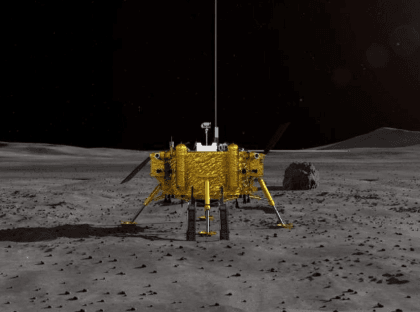China's Chang'e 4 probe makes historic touchdown
China’s Chang’e 4 probe spacecraft has become the first spacecraft to land on the far side of the moon.
Chang’e 4 is a Chinese lunar exploration mission that aims to achieve soft-landing on the far side of the Moon. The mission aims to deliver samples of Moon rock and soil to Earth.
About the Mission:
- For the first time, there would be soft-landing on the far side of the Moon.
- China’s mission consists of a static lander and rover.
- The rover will touch down on the Von Kármán crater, located on the side of the Moon which never faces Earth.
- During the landing, the probe will descend on thrusters and touch down on the rugged terrain of the lunar far side.
- The landers will aid in characterising the region’s geology and the composition of rock and soil.
- Chang’e-4’s instruments would examine whether the impact which created the South Pole Aitken Basin has punched through the crust down to the Moon’s mantle layer. This will shed light on the early history of our only natural satellite.
- The Chang’e-4 mission will also characterise the “radio environment” on the far side to lay the groundwork for the creation of future radio astronomy telescopes on the far side, which is shielded from the radio noise of Earth.
- To study the respiration of the seeds and the photosynthesis on the Moon the static lander is carrying a container with potato and Arabidopsis plant seeds to perform a biological experiment.
- The lander will send the data through the satellite Queqiao of China.
Von Kármán crater and the far side of Moon:
- Von Kármán crater is located within the oldest and largest impact feature on the Moon – the South Pole-Aitken Basin, which was formed by a giant asteroid impact billions of years ago.
- The far side of the moon is never visible from earth because of the phenomenon of tidal locking. As the Moon takes just as long to rotate on its own axis as it takes to complete one orbit of Earth, we are able to see only one face of the moon from the earth.
- Even though it is said as the dark side, it is also illuminated by the Sun and has the same phases as the near side. Dark in the context simply means unseen.
- The far side is rather different than the near side. The far side has a thicker, older crust that is pocked with more craters.
The Chang’e-4 mission is part of the Chinese larger lunar exploration mission. The first and second Chang’e missions were aimed at gathering data from orbit. The third and fourth missions concentrated on surface operations. The fifth and sixth are sample return missions, delivering lunar rock and soil to laboratories on Earth.
Month: Current Affairs - January, 2019


